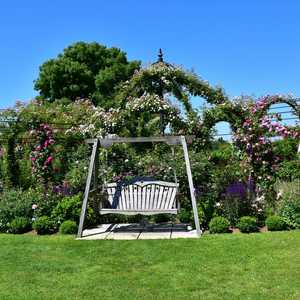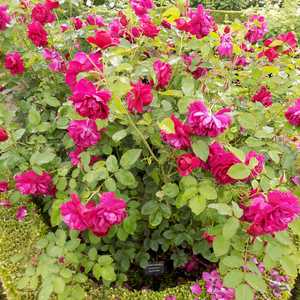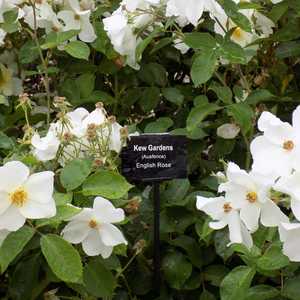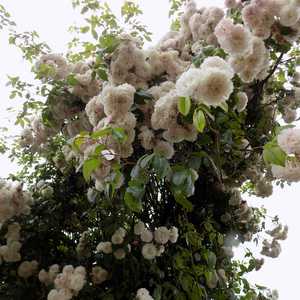National Gardening Week, Looking at Roses
by Katherine Crouch
Well it's #Nationalgardeningweek and after weeks of lockdown I had hoped to crack on with get-around-to-it jobs with a vengeance and by now be smugly up to date with spring cleaning, DIY projects and paperwork. I regret to say that not a lot of the housework to-do list has been ticked off. Quite frankly, this amazing spell of hot weather is completely unsuited to housework of any kind, and while the house has that comfortable freshly-burgled look, the garden has never looked better. I explain away the state of the house by telling visitors the butler is on furlough.
I resolve to catch up with one overdue job while the noonday sun is too hot for gardening, to turn some rough notes made 3 years ago into this blog. I went to a gardeners and landscapers Trade Day at David Austin Roses in near Wolverhampton in June 2017. It was a great day out, with a fellow gardener for company, and we were given a tour of the rose gardens, the rose fields and the propagating greenhouses, with an excellent lunch and a talk. Many specialist nurseries provide this opportunity, to cement relationships with professionals who will use their plants in a more informed way. It is a wonderful way to learn more about a kind of garden plant.
I know the folks at Sitting Spiritually love roses, especially for their ability to grow and twine around their bespoke pergolas, as in the main photo above, providing an excellent source of natural shade.
It was fascinating to see the greenhouse roses, with paper bags over the heads of pollinated flowers, all with a unique barcode to record which flower had been pollinated by what. The seed was collected, and sown, then grown on in a field the size of 4 football pitches. The resulting plants were observed for good and unique characteristics of health, vigour, colour, scent, habit and disease resistance for several seasons. From thousands of plants, only one or two are selected each year as a new introduction to the catalogue.
Catalogues make interesting reading. Superlatives abound in the descriptions of the plants, each better than the last. You learn to read between the lines. If one rose boasts of an intense perfume, and another is lauded for its disease resistance, and another for its bloom’s abilities to withstand rain damage, they may be lacking in the others’ virtues. It was most interesting to hear what characteristics never made it into the pages of the catalogue. It was a drizzly day, and you could see immediately which blooms suffered and which were unbowed.
I made notes as we went round, and here they are in no particular order. You may wish to compare the comments side by side with their catalogue description, for seldom do the drawbacks get a mention.
Kew Gardens, a white cluster-flowered shrub, makes a good informal hedge.
For long-lasting cut flowers, grow The Pilgrim, LD Braithwaite and especially Queen of Sweden, which has a good stem length and upward facing head.
Munstead Wood is the darkest purple rose but needs good care and feeding and does not tolerate neglect. The Generous Gardener and Gentle Hermione lose their petals quickly and are no good for cut flowers, but they are good for wet climates as they are not prone to ‘balling’ where the bud opens halfway then rots in the wet.
All David Austin rose colours go well together, but least successful are apricot pinks next to blue pinks. As The Alexandra Rose goes from apricot to blue pink, it is difficult to place….and no longer in the catalogue.
For a large shrub, grow Teasing Georgia, Shropshire Lad and The Generous Gardener.
St Cecilia’s Rose makes a good climber with lots of shoots from the base and will flower all the way up if you prune it at 1, 2 ,3 and 4 feet intervals. Sounds good…but it is no longer offered so it can’t have been that good.
Vigorous varieties are graded, 2 strong stems being reserved for the climbing version and 3 to 4 stem compact version kept for shrub roses. Shrubs should never be hard pruned like a hybrid tea rose but grown as a bush and lightly pruned to keep the base compact and free flowering. When bushes are young, especially the smaller ones, they do not hold themselves up well and are best grown as a group of three or more planted about 2 feet apart, and they will hold each other up. Dead head them back to the next shoot.
Kew Rambler attracts a lot of bees. If you want hips on your roses, choose the single flush wilder roses like dainty but faint scented Scepter’d Isle, The Generous Gardener and The Garland. Repeaters generally don’t produce hips. Princess Louise is a beautiful rambler, but with little scent. Adelaide Orlean, Felicite Perpetue and The Generous Gardener are evergreen, but need pruning in winter and taking all the leaves off the top to prevent overwintering disease.
Most roses do not thrive in the shade under trees, but many are happy in an open aspect in the shade of a north wall. Lady of Shallot and Gentle Hermione will climb up a hot south or west facing wall. However, roses will need a lot of water in these dry positions or they will be prone to mildew. Rambling roses are not a good idea for walls as their growth is too vigorous and lax to tame. They are just the thing for obliterating an ugly shed or tree stump but tend to flower only once in late May to midsummer.
Roses enjoy rich soil and will benefit from an annual mulch of compost and fertiliser. However manure should be composted well before applying as it is apt to introduce weeds to the border. Roses associate well in borders with Alchemilla mollis, catmint, alliums, daylilies, Ajuga Catlins Giant (if not too dry) Lychnis coronaria alba, Sedum matrona and Purple Emperor and Penstemon Garnet. Foxgloves are also good companions but need weeding out from under the roses for best effect. If room for one companion only, catmint is a soft blue that goes with every colour of rose, or phacelia tanacetifolia from seed which will cover the ground for little expense.
Scarborough Fair is very free flowering, tough, disease resistant with small pale pink flowers and good for the front of a border. Lochinvar looks half wild, prickly with Scottish blood. Sir Walter Scott is similar and only 2 feet high, perfect for a small informal garden. Wildeve is very healthy and a good landscape plant with perfectly quartered pink rosette blooms but does not catch the eye in the catalogue and is not a good seller. It deserves to be more popular.
Cordelia has upright growth but the flowers hang their heads. Blooming apricot and fading to peach pink in clusters, it is best grown to a good height to appreciate their flowers at eye level.
Princess Alice of Kent is coral in bud and blue pink, so looks like two different flowers on the same plant. Desdemona is one of the best whites, flushed with pale pink, very healthy with shiny leaves, although the scented flowers go over quite quickly. More companions for roses – Nepeta Kit Kat, Penstemon Apple Blossom and Erysimum Bowles Mauve.
Darcy Bussell is a rich cherry red, flowering abundantly and repeating well, but the scent is not as good as Munstead Wood. Lady of Megginch has big crimson flowers which looks a bit odd when the bush is new and small, but looks much better when bigger, so is underrated.
Gertrude Jekyll is the most popular variety of all and has the best scent, but the blooms hang their heads, so it is best grown as a tall shrub at the back of the border…ditto Lady of Shallot.
As well as roses bred by David Austin, they sell many other roses. Zephirine Drouhin is a 19th Century popular rich pink climbing rose. It is a tiresome beast which gets every disease going and for once the catalogue heads off the future complaints with the description “This thornless climbing rose prefers warmer climates. Controlling disease can be a problem”.
If you want to grow roses in containers, they must be very big, and 60cm by 60cm will not be too big, with three to five roses to make a dense display. They must be top-dressed annually, fed and watered a lot. All roses should be planted with the graft 50cm below ground level – ignore the outdated advice by the RHS!
After a fascinating talk from Michael Marriott, the technical manager and senior rosarian at David Austin roses, there was plenty of time for questions with tea and more cake. I suggested that many older varieties of their roses were named after male national treasures like James Galway in 2000, William Shakespeare, discontinued and superseded by Sir John Betjeman in 2008, but more of the recent introductions were named after women such as Claire Austin, David Austin’s daughter in 2007, Dame Judi Dench in 2017 and Emily Bronte in 2018. I asked why this should be.
The reply came that there was only a slight chance of Dame Judi going to the bad and being revealed as a brothel madam, and they were awfully glad they didn’t name a rose Sir Jimmy Savile or Rolf Harris!





With many thanks to Katherine Crouch
Katherine Crouch Garden Design
Telephone
Mobile
Posted on June 1st 2020

